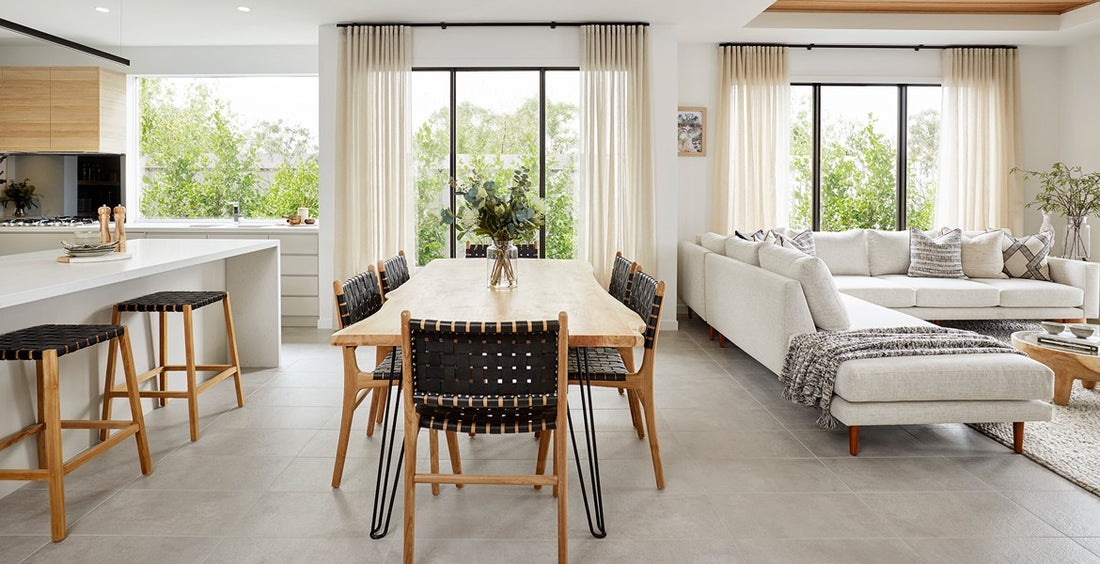We understand that choosing the best flooring for your home is a crucial decision that can significantly impact your daily life. The right floor can add warmth, texture, and character to your home, and it is important to consider factors such as durability, comfort, style, and maintenance before making your choice.
In this blog, we will explore some of the most popular flooring options available in the market and provide insights on how to choose the best floor for your home. Whether you are looking for plush carpets, durable hardwoods, unique tiles, or any other flooring option, we have got you covered.
The Importance of Choosing The Best Flooring For Your Home

Your home is a reflection of your personality, and your floors play a significant role in creating the ambiance you desire. When selecting the best flooring for your home, you should keep in mind that your floor is not just a surface to walk on, but an essential element of your home's design. Your floor sets the foundation for colour, style, texture, and pattern in the room, and investing in the right floor can significantly enhance the overall aesthetics of your home.
Moreover, the floors in your home are a significant financial investment, and selecting a surface that will last for many years is essential. You want to choose a floor that is comfortable and durable, regardless of whether you are performing yoga in your den, hosting a dinner party in your dining room, or entertaining the neighborhood kids in your kitchen.
Factors to Consider When Choosing The Best Flooring For Your Home

Choosing the right flooring for your home can be a daunting task. It is important to balance your home's needs and your floor's style when selecting the best flooring for your home. The following factors can help you make an informed decision.
Identify Your Style
When choosing the best flooring for your home, you should first consider the style you prefer. Do you like traditional or contemporary designs? What are your favorite colours and patterns? Identifying your favorite floor texture, such as hardwood's rich grain, carpet's luxurious thickness, or tile's sleek lines, can also be helpful. It is crucial to consider your current decor and choose floors that complement the furniture and accessories you already have unless you plan to redecorate the entire room.
Consider Your Lifestyle
Your lifestyle plays a significant role in choosing the best flooring for your home. Put yourself in the room and think about how you plan to use it. Do you enjoy cooking and spending hours standing at the stove? Then you might want to skip the tile, since it may be uncomfortable to stand on for a long period of time. Do you have kids who leave puddles of water on the bathroom floor? Consider using flooring that can withstand water. Are there pets in your home that track mud into the front hall? The floor should be able to withstand the wear and tear your family dishes out, as well as accommodate your activities.
Analyze The Cost
It is important to consider your budget when selecting the best flooring for your home. Along with the floor material cost, you may need to incorporate the cost of underlayment, delivery, and installation, as well as removal and disposal of your previous flooring. Don't forget to factor in any additional materials such as baseboards, stains, or adhesives.
Consider The Durability
Durability is another critical factor to consider when choosing the best flooring for your home. Soft flooring tends to last shorter than hard floors. For high-traffic areas, laminate flooring and vinyl flooring are both durable options. A major advantage of laminate is its scratch resistance - an important factor for homeowners with pets - while sheet vinyl and luxury vinyl are water-resistant. Another durable option is porcelain tile - it would take an incredible amount of force to scratch or damage a tile floor.
The Comfort Level
If you are seeking a soft, comfortable floor covering, carpet flooring may be the right choice for you. Nothing is more comfortable underfoot than soft, cushy carpeting. Using carpet in your home reduces noise, is highly durable, protects little children from bruises if they take a tumble as they learn to walk, and is the best option to sit on during family movie night. For those who are concerned about comfort, but prefer hard surface flooring, it might be a good idea to consider vinyl or cork flooring which is softer underfoot. Especially in kitchens, where people will spend a lot of time on their feet, this is an important consideration.
Environmental Concerns
With growing awareness about the impact of consumer choices on the environment, many homeowners are looking for sustainable flooring options that minimize their carbon footprint. Eco-friendly flooring options such as bamboo, cork, and reclaimed wood are becoming increasingly popular. These materials are renewable, biodegradable, and have a lower environmental impact compared to traditional flooring options. Additionally, some flooring manufacturers offer products that are made with recycled materials, which can also be a great eco-friendly choice.
Some popular options include bamboo, cork, and reclaimed hardwood. Bamboo flooring is a highly sustainable option because it grows rapidly and regenerates quickly, making it an ideal choice for environmentally conscious homeowners. Cork flooring is also an eco-friendly option, as it comes from the bark of the cork oak tree and can be harvested without damaging the tree. Reclaimed hardwood is another sustainable option, as it involves repurposing old wood from buildings or furniture and giving it new life as flooring.
The Aesthetic Appeal
While the practical aspects of flooring are important, the aesthetic appeal should not be overlooked. The flooring you choose can have a significant impact on the overall look and feel of your home. For example, hardwood flooring can give your home a warm and inviting feel, while tile can create a sleek and modern look. Carpeting, on the other hand, can add a cozy and comfortable touch to your space. Make sure to choose a flooring option that not only meets your practical needs but also enhances the aesthetic appeal of your home.
Consider Your Region
The climate and region you live in can also impact the type of flooring that works best in your home. In areas with high humidity levels or frequent rain, hardwood flooring may not be the best choice as it can warp or buckle. Similarly, in areas with extreme temperatures, some flooring materials may not hold up well. It's important to consider the unique environmental factors of your region when selecting a flooring material.
Think About Resale Value
When choosing the best flooring for your home, it is also important to consider its potential impact on the resale value of your home. Some flooring materials, such as hardwood or tile, can increase the value of your home and make it more attractive to potential buyers. On the other hand, choosing an unconventional or outdated flooring material may make your home less appealing to buyers.
Installation Process
Another factor to consider when choosing the best flooring for your home is the installation process. Some types of flooring, such as carpet or vinyl, can be installed relatively easily and quickly, while others, such as hardwood or tile, require more specialized skills and equipment. It is important to factor in the cost and time required for installation when choosing your flooring.
Maintenance and Repair
Finally, it is important to consider the maintenance and repair requirements of different types of flooring. Some types of flooring, such as hardwood, require regular maintenance, such as polishing or refinishing, to keep them looking their best. Others, such as vinyl, are more low-maintenance and only require occasional cleaning. It is also important to consider the ease of repair in case of damage, as some types of flooring may be more difficult or expensive to repair than others.
Keeping a floor clean and maintained is a necessary part of maintaining it. In terms of daily maintenance, carpeting requires the most attention. Its fibers are able to trap dirt, dust, dander, and allergens, so you will need to vacuum the carpet frequently. It should also be noted that carpets do tend to become dingy over time, especially if the colours are lighter, and if spills are not cleaned immediately, they may leave permanent stains. There are however some manufacturers who create carpets that repel stains and spills, as well as hypoallergenic options, that can withstand a hectic household environment.
In conclusion, choosing the best flooring for your home requires careful consideration of a variety of factors, including style, lifestyle, budget, durability, comfort, maintenance, and environmental impact. By weighing these factors and selecting a flooring option that meets your specific needs and preferences, you can create a beautiful and functional living space that will stand the test of time. Whether you prefer the warmth of hardwood, the comfort of carpeting, or the durability of tile, there is a flooring material that can meet your needs. Remember to also think about environmental concerns, regional factors, and potential resale value when making your decision.
Remember, investing in high-quality flooring is a wise decision that can pay off in the long run by increasing the value and enjoyment of your home.
What Are The Best Flooring For Your Home
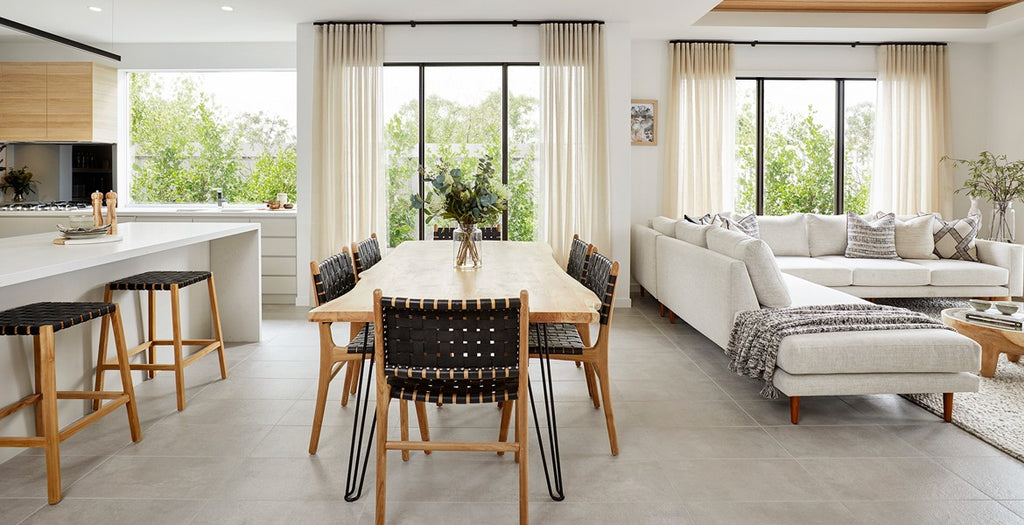
By taking the time to choose the right flooring for your home, you can ensure that you will enjoy your investment for many years to come.
To help you choose the best floor for your home, here are some more detailed insights into each type of flooring:
1. Hardwood Flooring

Hardwood floors are a popular choice for their warmth, natural beauty, and durability. They can last for many years with proper care and can add value to your home. However, they can be expensive to install and require regular maintenance, such as refinishing and polishing. Hardwood flooring is a good option for high-traffic areas, but may not be the best choice for areas prone to moisture, such as bathrooms or basements.
- Durability - Hardwood floors are known for their strength and durability. They can withstand the wear and tear of heavy foot traffic and are resistant to scratches and dents. With proper care, they can last for decades.
- Appearance - Hardwood floors add warmth and beauty to any room. They come in a variety of colors and grain patterns, making it easy to match your decor.
- Easy to clean - Hardwood floors are easy to maintain and clean. They only require sweeping and occasional mopping to keep them looking their best.
- Health benefits - Hardwood floors do not trap dust, allergens, or harmful chemicals like carpeting can. They promote healthier indoor air quality, making them a great choice for those with allergies or respiratory issues.
- Increased home value - Hardwood floors are a highly sought-after feature in homes. Adding hardwood flooring can increase the resale value of your home and can be an attractive selling point.
2. Engineered Hardwood Flooring
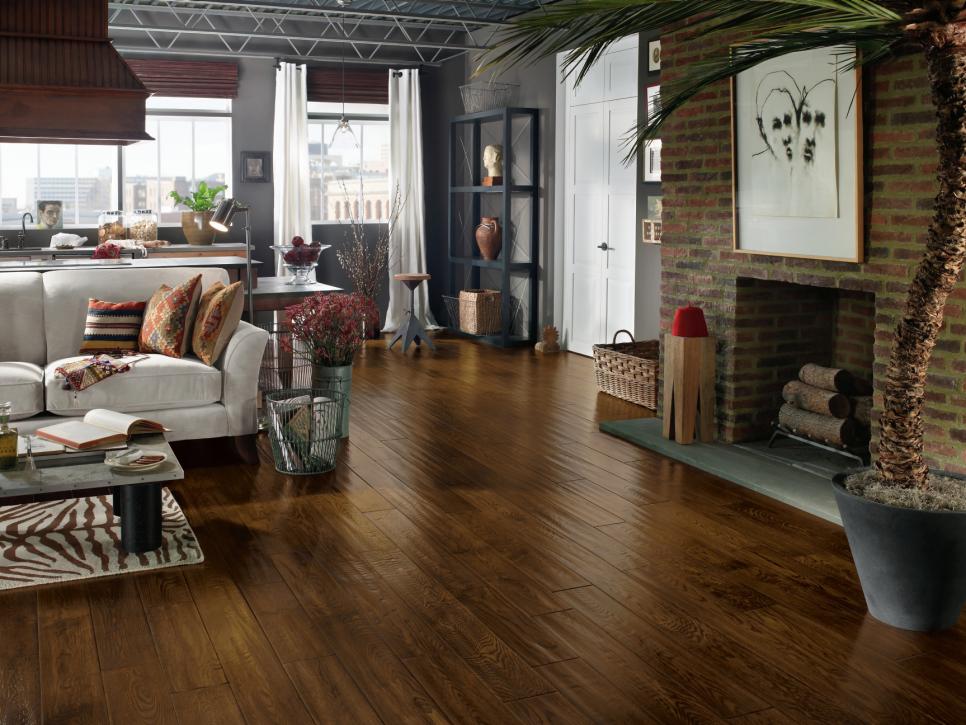
One of the key benefits of engineered hardwood flooring is its exceptional stability, which makes it an excellent choice for homes with concrete subfloors.
Unlike solid hardwood flooring, which is prone to expanding and contracting with changes in humidity and temperature, engineered hardwood is constructed with layers of wood that are arranged in a cross-grain pattern. This cross-grain configuration provides the engineered hardwood with greater dimensional stability than solid hardwood, which means it is less likely to warp, cup, or bow in response to moisture or temperature changes.
Additionally, the construction of engineered hardwood flooring allows it to be installed as a floating floor, which means it is not attached directly to the subfloor. Instead, the flooring is installed with an underlayment that provides a barrier between the flooring and the concrete subfloor, which helps to reduce the transfer of moisture and heat from the concrete to the flooring.
This stability makes engineered hardwood an ideal choice for homes with concrete subfloors, which can be prone to moisture issues and temperature fluctuations. By choosing engineered hardwood, homeowners can enjoy the beauty and warmth of hardwood flooring without having to worry about the potential problems associated with solid hardwood on a concrete subfloor.
Engineered hardwood flooring is a popular choice among homeowners for a number of reasons. Here are some insights on why it's considered a great flooring type for your home:
- Durability: Engineered hardwood flooring is more durable than traditional solid wood flooring, as it is constructed with multiple layers of wood and resin. This makes it less susceptible to expansion and contraction due to changes in humidity and temperature, and more resistant to scratches and dents.
- Cost-effective: Engineered hardwood flooring is less expensive than solid wood flooring, yet still provides the same aesthetic appeal and durability. This makes it an affordable option for homeowners who want the look and feel of hardwood without the high price tag.
- Easy to install: Engineered hardwood flooring is designed to be easy to install, with options such as click-lock systems and glue-down installations. This makes it a popular choice for DIY projects and for homeowners who want a quick and easy installation process.
- Aesthetically pleasing: Engineered hardwood flooring offers a wide range of colours, styles, and finishes, making it a versatile flooring option that can complement any interior design style. From traditional to modern, there is an engineered hardwood flooring option to suit every taste.
- Environmentally friendly: Engineered hardwood flooring is made with sustainable materials and uses less hardwood than traditional solid wood flooring. This makes it an environmentally friendly choice for homeowners who want to reduce their carbon footprint while still enjoying the beauty of hardwood flooring.
Overall, engineered hardwood flooring offers a range of benefits that make it a great flooring type for your home. Its durability, affordability, ease of installation, aesthetic appeal, and environmental friendliness are just a few reasons why it's a popular choice among homeowners.
3. Vinyl Flooring
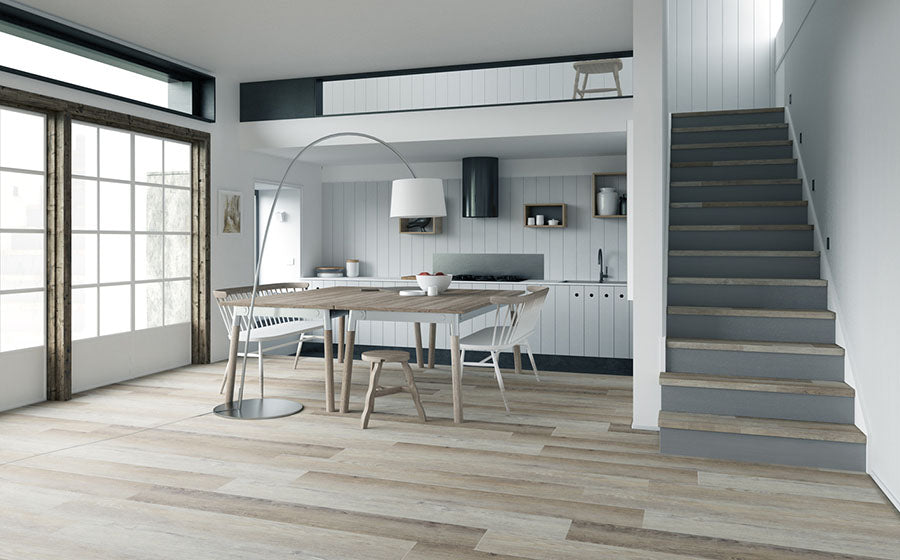
Vinyl flooring has gained popularity over the years because of its durability, affordability, and ease of maintenance. Vinyl flooring comes in different forms, including sheet, tile, and plank, each with its unique properties.
One of the benefits of vinyl flooring is its water resistance, making it an ideal choice for areas like the bathroom, laundry room, and kitchen. Vinyl plank flooring, in particular, is waterproof and can withstand spills and water splashes without warping or buckling. This makes it a perfect option for households with pets or children who are more likely to spill liquids.
Another advantage of vinyl flooring is its ease of maintenance. Vinyl floors require only regular sweeping and mopping to keep them clean, unlike carpets, which trap dust and allergens, and requiring frequent vacuuming. Vinyl flooring is also resistant to stains, scratches, and dents, making it a great option for high-traffic areas.
Vinyl flooring is available in different colours, styles, and patterns, making it easy to match with any decor. With advancements in technology, vinyl flooring can now mimic the look and feel of natural materials like hardwood, stone, and ceramic tiles. For instance, luxury vinyl tiles (LVT) can be made to resemble hardwood planks or natural stone tiles, creating an elegant look without the high cost of installation and maintenance.
Vinyl flooring is also known for its comfort underfoot. Vinyl planks and tiles are softer than hardwood or ceramic tiles, which can be uncomfortable to stand on for long periods. This makes vinyl flooring an excellent choice for kitchens, where people tend to spend a lot of time standing while cooking or preparing food.
However, one of the drawbacks of vinyl flooring is that it can emit volatile organic compounds (VOCs) that may be harmful to human health. While manufacturers have reduced the number of VOCs in their products, it is essential to choose low-VOC or no-VOC options when installing vinyl flooring in your home.
Overall, vinyl flooring is a practical and versatile option that can provide comfort, durability, and style at an affordable cost. When choosing the best flooring for your home, it is worth considering vinyl flooring as a viable option.
4. Bamboo Flooring
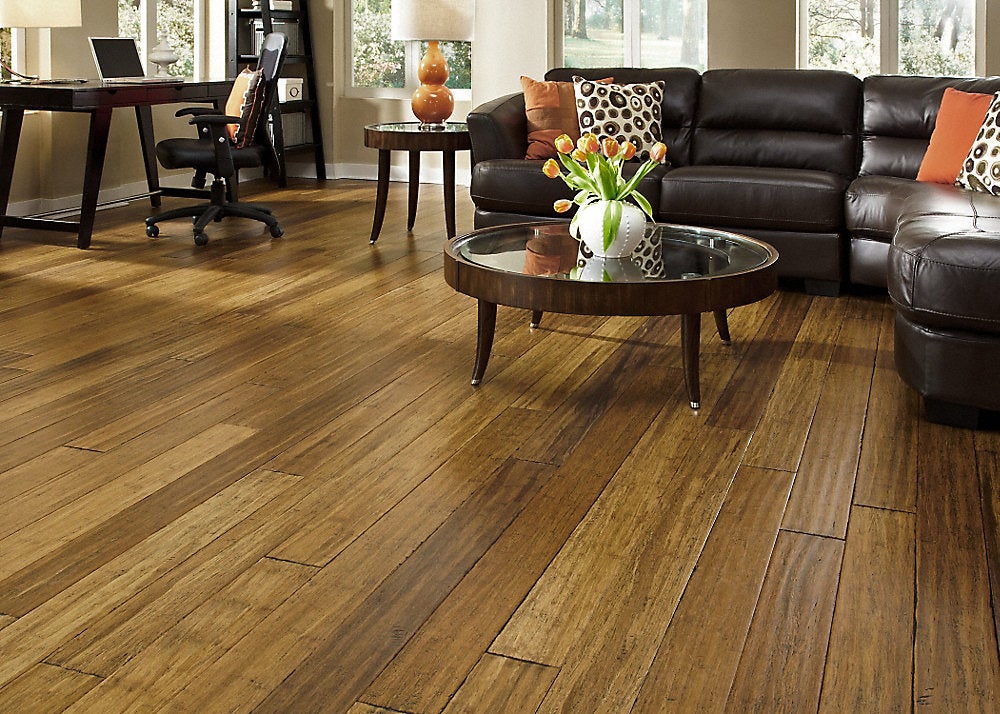
Bamboo flooring is becoming an increasingly popular option for homeowners who want a sustainable and eco-friendly alternative to hardwood flooring. Here are some insights on bamboo flooring:
- Durability: Bamboo flooring is extremely durable and can last for years if maintained properly. It is harder than most hardwoods, such as oak, and is less prone to scratches and dents. However, it is important to note that the quality and durability of bamboo flooring can vary depending on the manufacturing process and the type of bamboo used.
- Sustainability: Bamboo is a renewable resource that grows quickly and is harvested without harming the environment. It is also a great alternative to hardwood, which requires cutting down entire trees. Bamboo is an environmentally-friendly choice for homeowners who want to reduce their carbon footprint.
- Styles: Bamboo flooring comes in a wide range of styles, colours, and finishes. It can be found in natural, carbonized, or stained variations. It can also be installed in a variety of patterns, such as horizontal, vertical, or strand-woven.
- Maintenance: Bamboo flooring is relatively easy to maintain. It can be swept, vacuumed, or cleaned with a damp mop. It is important to avoid using harsh chemicals or abrasives, as they can damage the surface. It is also important to wipe up spills immediately to prevent water damage.
- Cost: Bamboo flooring is generally more affordable than hardwood flooring, although the cost can vary depending on the quality and style. It is important to factor in the cost of installation, as well as any additional materials such as underlayment and baseboards.
Overall, bamboo flooring is a sustainable and stylish option for homeowners who want a durable and eco-friendly alternative to hardwood flooring. However, it is important to do research and choose a high-quality product to ensure longevity and durability.
5. Area Rugs
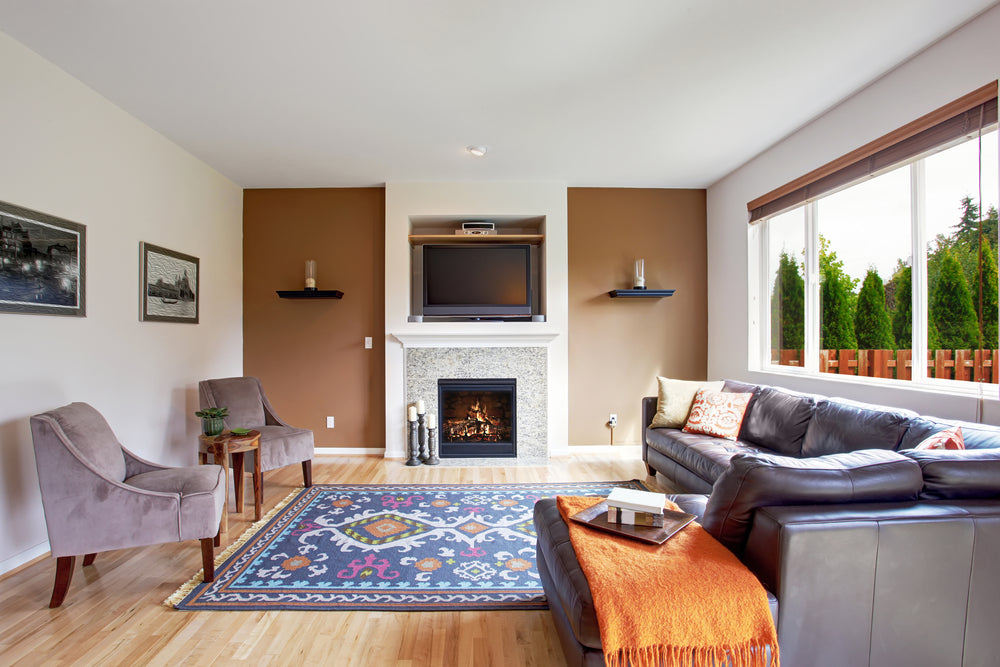
Area rugs are an excellent way to add style, comfort, and functionality to any space in your home. Here are some benefits of using an area rug in your home:
Style: An area rug can instantly enhance the style of any room. It can add colour, texture, and pattern to your flooring and create a focal point in your space.
Comfort: Area rugs are soft and plush, which makes them perfect for creating a cozy and comfortable atmosphere in your home. They can provide warmth and insulation, making your room feel more inviting.
Protection: Area rugs can protect your flooring from scratches, stains, and wear and tear. They can also protect your feet from cold or hard surfaces, making them ideal for areas such as bedrooms, living rooms, and playrooms.
Soundproofing: Area rugs can absorb sound and reduce noise levels in your home. This is particularly useful if you have hardwood or tile floors that tend to amplify noise.
Versatility: Area rugs come in various sizes, shapes, and colours, making them versatile decor items that can suit any room in your home. You can use them to define a seating area, create a pathway, or simply add a pop of colour to your space.
The best areas in your home suited for area rugs include:
- Living rooms: An area rug can anchor your seating area and create a cozy space for socializing and relaxing.
- Bedrooms: An area rug can add warmth and softness to your bedroom floor, making it more comfortable and inviting.
- Dining rooms: An area rug can help define your dining area and add a touch of elegance to your space.
- Entryways: An area rug can make a welcoming statement in your entryway and protect your flooring from dirt and wear and tear.
- Playrooms: An area rug can provide a soft and safe surface for children to play on, protecting them from hard or cold flooring.
6. Carpet Flooring

If you are seeking a soft, comfortable floor covering, carpet flooring may be the ideal option for you. Carpeting is known for providing a comfortable and cozy surface that feels great underfoot. It can help to create a warm and inviting atmosphere in any room. Carpeting is also a great option for those who want to reduce noise levels in their homes, as it can help to absorb sound and reduce echo. Additionally, carpeting can help to insulate your home and keep it warmer in the winter, as it provides an extra layer of insulation on top of the subfloor. Overall, if you are looking for a comfortable and cozy flooring option, carpeting is definitely worth considering."
7. Cork flooring
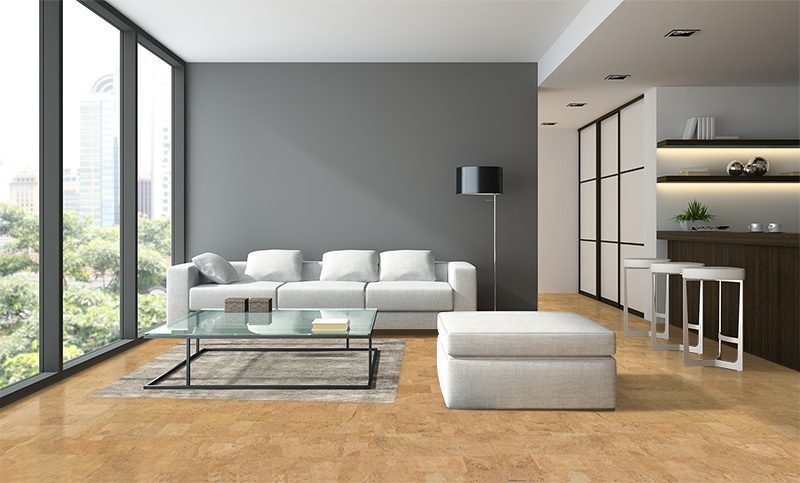
Cork flooring is a unique and eco-friendly option for homeowners looking for a versatile and durable flooring solution. Here are some insights to consider when it comes to cork flooring:
- Sustainability: Cork flooring is a sustainable choice as it is made from the bark of cork trees, which grow back every 9-12 years, making it an eco-friendly material. It is also biodegradable, so it won't contribute to landfill waste.
- Durability: Despite its soft and spongy feel, cork is highly durable and can last for years when maintained properly. It can withstand heavy foot traffic and is resistant to scratches and dents.
- Comfort: Cork flooring is soft and comfortable underfoot due to its natural cushioning properties, which makes it a popular choice for high-traffic areas and homes with young children or pets.
- Insulation: Cork flooring is a natural insulator, which means it can help keep your home warm in winter and cool in summer. It can also help reduce noise and vibrations, making it a great option for apartments or homes with shared walls.
- Easy to install: Cork flooring is relatively easy to install and can be done as a floating floor or glued down. It can also be installed over existing floors, which makes it a great choice for remodeling projects.
- Design versatility: Cork flooring comes in a range of colours and patterns, allowing you to create a unique look for your home. It can mimic the look of hardwood, stone, or tile, and can also be stained or painted to suit your design preferences.
Overall, cork flooring is a great option for homeowners who value sustainability, durability, comfort, and insulation in their flooring choices. It is versatile, easy to install, and comes in a range of designs to suit any home décor style.
8. Laminate Flooring

Laminate flooring is an affordable and durable option that can mimic the look of hardwood, tile, or stone. It is easy to install and maintain, making it a great choice for DIY projects. However, it can be prone to scratching and may not be as long-lasting as hardwood or tile. Laminate flooring is a good option for high-traffic areas, but may not be the best choice for areas prone to moisture.
- Affordability: Laminate flooring is an affordable flooring option that mimics the look of expensive flooring materials such as hardwood, stone, and tile.
- Durability: Laminate flooring is highly durable, scratch-resistant, and easy to maintain. It can withstand wear and tear from heavy foot traffic, pets, and spills.
- Versatility: Laminate flooring comes in a wide range of colours, styles, and patterns, making it easy to find a flooring option that complements your home's décor.
- Easy installation: Unlike hardwood, tile, or stone, laminate flooring can be installed quickly and easily without the need for professional installation. Many laminate flooring options feature an interlocking design that snaps together like puzzle pieces.
- Resistant to moisture and stains: Laminate flooring is resistant to moisture and stains, making it an ideal flooring option for high-traffic areas, kitchens, and bathrooms.
- Environmentally friendly: Laminate flooring is made from sustainable materials and is a great eco-friendly flooring option for homeowners who are mindful of their carbon footprint.
- Comfort: Laminate floors come with foam underlayment that provides shock absorption, making them comfortable to walk and stand on for longer periods.
9. Tile Flooring

Tile flooring is a popular choice for bathrooms and kitchens due to its durability and water resistance. It comes in a variety of styles, from sleek and modern to classic and traditional. However, it can be expensive to install and can feel cold underfoot. Tile flooring is an excellent flooring option for your home for several reasons. First, it is incredibly durable and can withstand high-traffic areas, making it perfect for households with pets or children. Additionally, tile flooring is water-resistant, which is essential in areas such as bathrooms and kitchens, where spills are common. Tile flooring is not only practical but also offers a beautiful, versatile, and long-lasting for your home.
- Durability: Tile flooring is known for its durability and long-lasting nature. It is highly resistant to scratches, stains, and water damage.
- Variety: Tile flooring comes in a wide range of colours, patterns, and textures, allowing you to customize the look of your floor to match your décor and taste.
- Low maintenance: Tile floors are relatively easy to clean and maintain. All you need is a mop and a mild cleaning solution to keep them looking their best.
- Hygienic: Tile flooring does not trap dust and allergens, making it an excellent choice for individuals with allergies or asthma.
- Indoor air quality: Tiles do not emit any VOCs (volatile organic compounds) that pollute the air in your home.
- Resale value: Tile flooring adds value to your home, making it an attractive option for potential buyers.
- Cost-effective: Tile flooring is an affordable flooring option compared to hardwood, marble, and other expensive flooring options.
- Versatile: Tile flooring can be installed in any room in the house, including kitchens, bathrooms, and basements.
What Are The Best Floors For Below-Grade Installation?
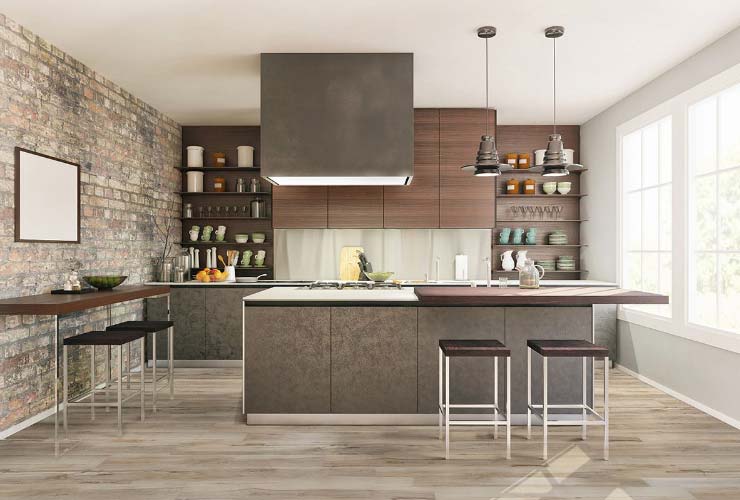
The best flooring options for below-grade installations are those that can withstand moisture and potential flooding. Here are some of the best flooring options for below-grade installation:
Luxury Vinyl Tile (LVT) - LVT is waterproof, durable, and easy to maintain, making it an excellent option for below-grade installations.
Ceramic Tile - Ceramic tile is a highly durable and moisture-resistant flooring option, making it suitable for below-grade installations. It is also easy to clean and comes in a variety of styles and designs.
Concrete - If you have a concrete subfloor in your below-grade space, consider polishing and staining the concrete for a unique and durable flooring option.
Engineered Hardwood - Engineered hardwood is made with a plywood base, which makes it less susceptible to moisture damage than traditional hardwood flooring. It is also easy to install and can be sanded and refinished several times.
Epoxy Flooring - Epoxy flooring is a highly durable and moisture-resistant option that can withstand heavy foot traffic and spills. It can also be customized with a variety of colours and designs.
It's important to note that proper installation and moisture control are critical for any flooring option installed below grade to ensure longevity and prevent damage.
Most Frequently Asked Questions About Flooring:
Is Laminate A Good Option Below Grade?
Laminate flooring is not recommended for below-grade installation. This is because laminate is made of fiberboard, which can be prone to warping and swelling when exposed to moisture. Below-grade areas are more susceptible to moisture issues due to their proximity to the ground and the potential for moisture intrusion through the foundation or basement walls.
If you are looking for a durable and moisture-resistant option for below-grade areas, consider engineered hardwood, luxury vinyl plank, or ceramic tile flooring. These materials are better suited for areas with high moisture and humidity levels and can withstand moisture-related issues without warping or deteriorating over time.
Is Solid Hardwood Recommended For Below-Grade Installation?
Solid hardwood is generally not recommended for below-grade installation because it is more susceptible to moisture damage and can warp or buckle. Moisture levels are typically higher in below-grade environments, making it more challenging to maintain solid hardwood flooring. It is important to select a flooring material that can withstand the unique conditions of below-grade installation, such as higher humidity and potential moisture infiltration. Some options for below-grade installation include engineered hardwood, vinyl, and ceramic tile.
Can I Use Rubber Flooring In The Home? Where Would It Best Be Installed?
Yes, rubber flooring can be used in the home. It is a durable and resilient flooring option that can handle heavy foot traffic, making it a great choice for high-traffic areas like entryways, mudrooms, and basements. Rubber flooring is also slip-resistant, making it ideal for areas that may get wet, such as kitchens, bathrooms, and laundry rooms.
Rubber flooring is available in a range of colours and textures, allowing it to fit a variety of design styles. It is also easy to maintain and clean, making it a practical choice for busy households. However, it is important to note that rubber flooring can have a strong odor when first installed, and some people may be sensitive to the smell.
One consideration when using rubber flooring in the home is that it can be quite hard and may not be as comfortable underfoot as other flooring options. This can be addressed by using rubber mats or rugs in areas where more cushioning is desired. Additionally, while rubber flooring is durable, it may not be the best choice for areas where heavy furniture or equipment will be placed, as it can dent or indent over time.
Is Rubber Flooring A Good Idea For Home Gym?
Yes, rubber flooring can be a great option for a home gym. Rubber is a highly durable and resilient material that can withstand heavy foot traffic, equipment weight, and impact from dropped weights or other gym equipment. It provides a cushioned surface that can help reduce strain on the joints, making it a comfortable and safe option for workouts.
Rubber flooring is also non-slip, which can prevent accidents and injuries in a home gym. It is easy to clean and maintain and can be found in a variety of colours and designs to fit any gym aesthetic.
When choosing a rubber flooring for a home gym, look for options with high density and thickness to provide the best shock absorption and durability. It's also important to ensure that the flooring is properly installed with adequate subflooring and adhesive to prevent shifting or buckling during intense workouts.
If you are looking for the best flooring for your home, there are a number of options available to you. There are plush carpets, durable hardwoods, unique tiles, and many more options to explore. It is important to keep in mind that each floor covering is unique and has its own benefits and drawbacks.
Final Thoughts On The Best Flooring For Your Home
In general, hard surface flooring requires less maintenance than soft surface flooring. Staining and dinginess are usually not a problem when the hard surface flooring is cleaned fairly regularly. So the best flooring for your home will depend on a lot of factors such as your preferred style, foot traffic, budget, durability, etc. After you have considered all of these, you can decide the type of flooring that is best suited for your needs.
Other flooring blog articles you may want to read:
Plants That Match The Flooring Of Your Home
Tips On Choosing Flooring On a Budget
